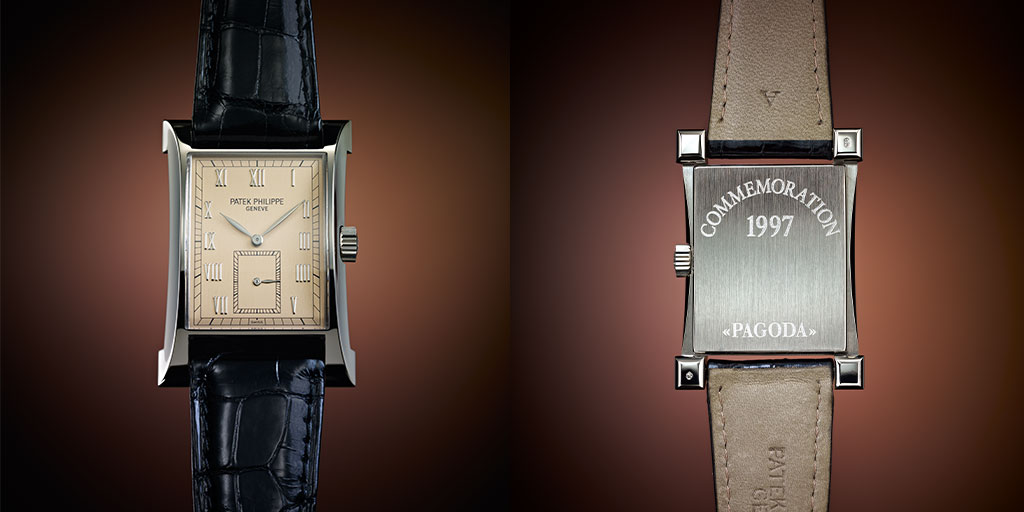On one of my first visits to Patek Philippe in Geneva in the 1990s, soon after I had joined the company, I had the privilege of standing on a vast, flat expanse of concrete foundation with Philippe Stern. This foundation was located in the then quiet suburb of Plan-les-Ouates, an area of mostly fields near the airport. Mr. Stern was explaining his vision for the future of his company and how all the workshops around Geneva would relocate here under one roof. At that time, it was hard to see his vision but on my next trip, to celebrate the opening of the new workshops in 1997, it was crystal clear.
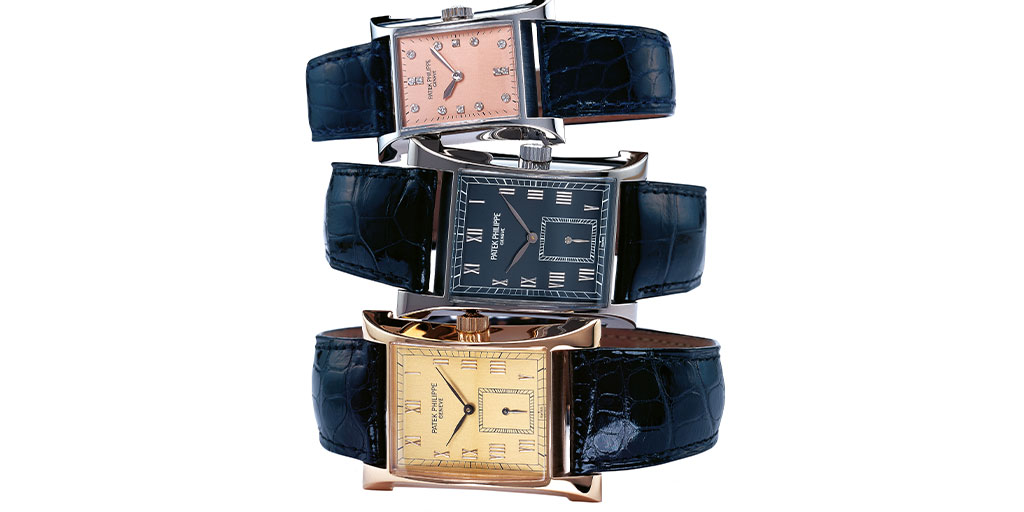
Philippe Stern was justifiably proud of his new building. It represented the accumulation of Patek Philippe’s then almost 160 year history. To bring around twelve different workshops, scattered throughout Geneva into a state-of-the-art emporium to watchmaking was a feat no one thought possible. Yet Philippe Stern was tenacious, and after the success of the company’s 150th anniversary celebrations he was confident enough to invest a year’s worth of sales into financing the project. Compared to the previous headquarters on Rue du Rhone, the building was enormous and it was difficult to imagine filling it. Plus, the area was devoid of any other watchmakers, or anything except for a Migro supermarket and a few small commercial buildings. But within a few years the building was full and surrounded by other watchmaking manufactures such as Rolex, Vacheron Constantin and Piaget . By 2003, the Stern family had to invest further and build another building to accommodate the company’s rapid growth.
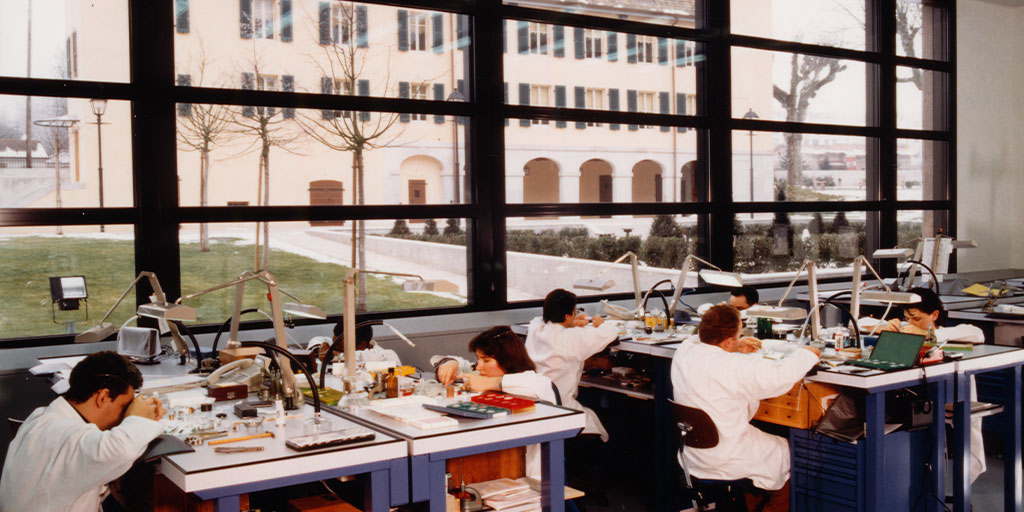
To celebrate the inauguration, Patek Philippe presented a series of limited edition watches for men and women. According to the 1997 brochure: “Patek Philippe’s first ever commemorative watches introduce an historic design that fills a gap in many private collections. Inspired by a rare 1940s model, Patek Philippe captures the 20th century artistic ideal by reconciling beauty and function in a streamlined sculpture of curves.”
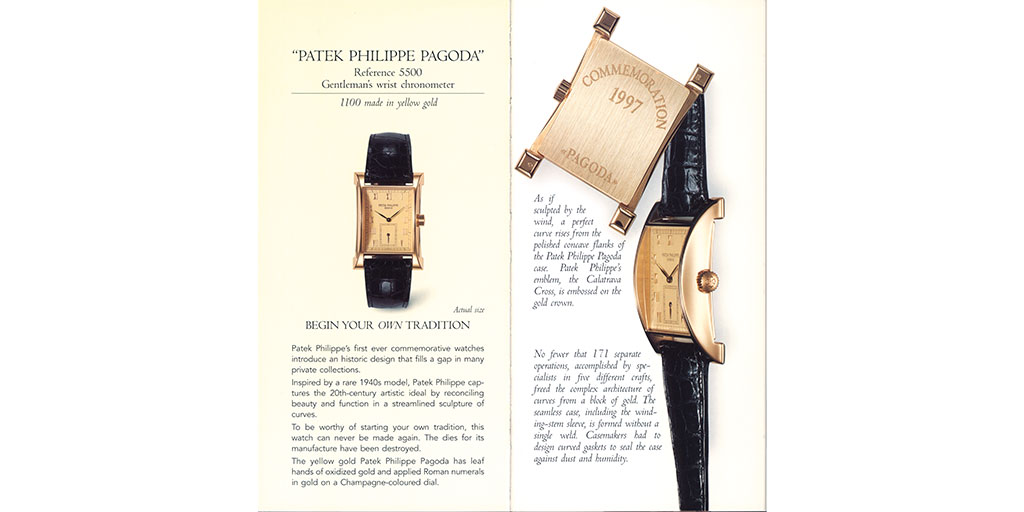
The Patek Philippe Pagoda, ref. 5500 for men and ref. 4900 for women, was an exciting, avant-garde design that reflected the experimental period of Art Deco – before the more conventional 1950s when most watches were housed in a round case. The beautifully sculptured, curved case was a theme echoed at the entrance to the new building where a magnificent spiral sculpture welcomed visitors to this new world of fine watchmaking. The complex case design required 171 separate operations, achieved by specialists in five different crafts to produce the architectural curves from a block of gold. Even the gaskets had to be curved to seal the case against dust and humidity.
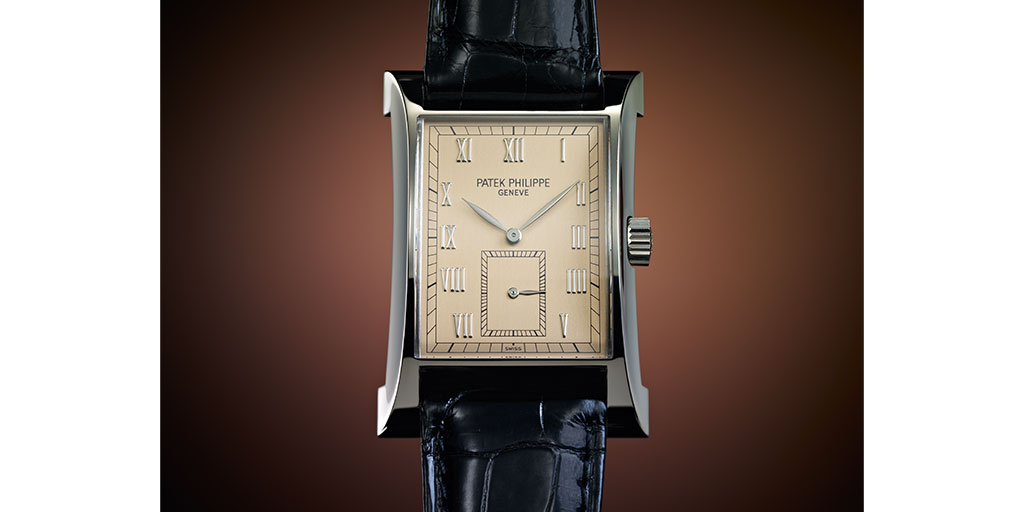
For the men’s ref. 5500, 1100 were made in 18K yellow gold with leaf hands of oxidized gold and applied Roman numerals in gold on a champagne-colored dial; 500 in 18K rose gold with a silvered dial in a vertically brushed satin finish with rose leaf hands and Roman numerals; 250 in 18K white gold with a rose-colored dial and Roman numerals in polished white gold; and 150 in platinum with its leaf hands and applied Roman numerals in white gold against a black dial. Each dial featured a distinctive seconds hand with a rectangular track at 6 o’clock. Once the production was completed, the dies to make the cases for each reference were destroyed.
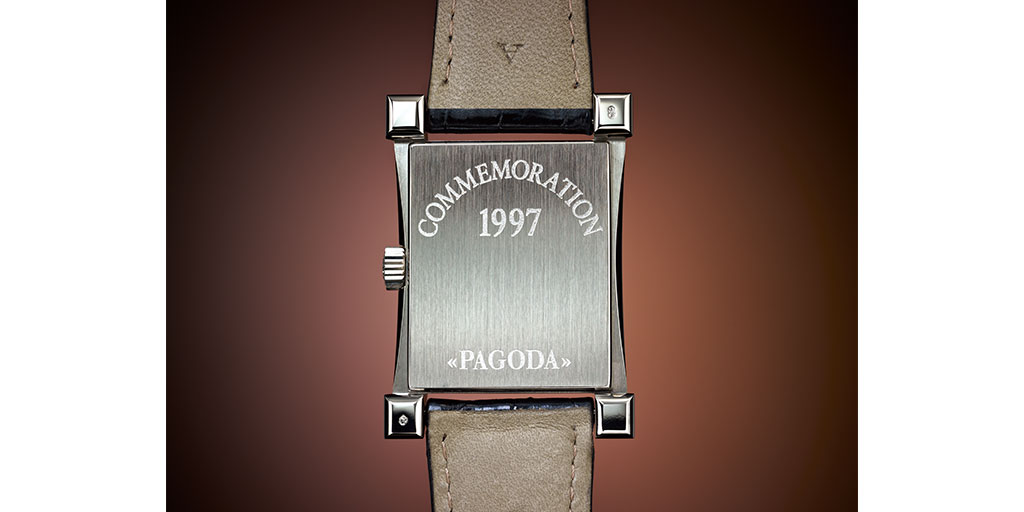
Each of the 2000 Pagoda men’s 27 mm x 41 mm cases were fitted with a caliber 215 PS, a manually wound chronometer with small seconds. For the first time in watchmaking history, to celebrate the accuracy of this movement, Switzerland’s official chronometer certification bureau C.O.S.C. (Contrôle Officiel Suisse des Chronomètres) and the Geneva Seal Authority joined together to issue an exclusive, individual rating-certificate for each of the ref. 5500 commemorative watches (see image below).
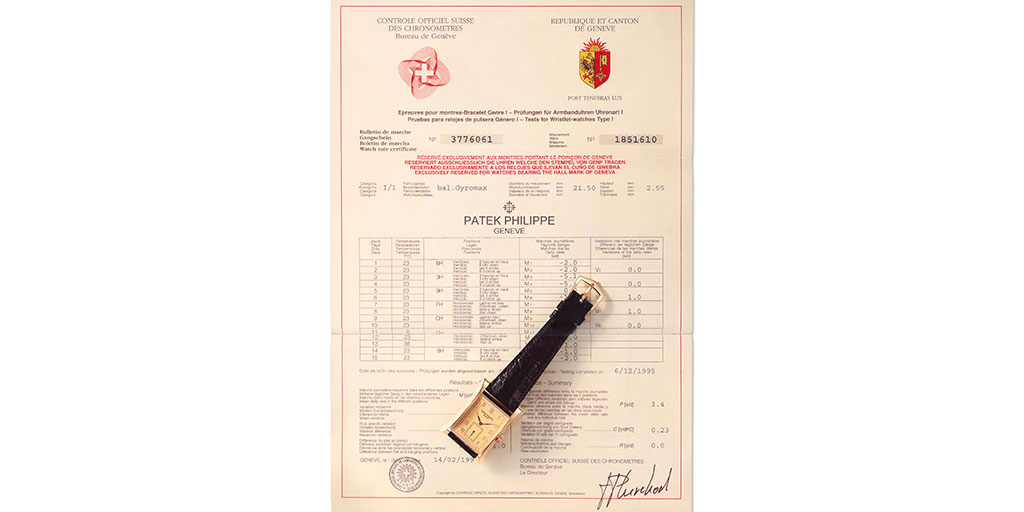
Each certificate shows the mean daily rate and the mean variation of each movement in several positions over a 15 day period. The mean daily rate indicated the average gain or loss – a correction factor for true time. The mean variation indicated the regularity of that gain or loss – a real indicator of accuracy.
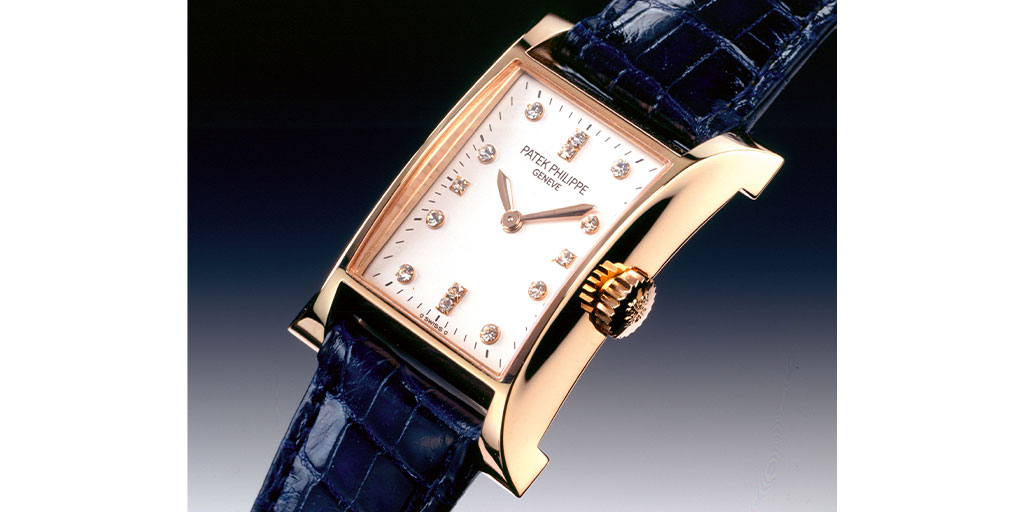
For the ladies Pagoda, the production numbers were less than half of the number produced for men (750 vs 2000). A total of 500 were made in 18K yellow gold with a silvered dial with diamond hour markers; 150 in 18K rose gold with a silvered opaline dial and diamond hour markers; and 100 in 18K white gold with a salmon dial and diamond hour markers. As with the men’s ref. 5500, the case dies were destroyed after production. The ref. 4900 25 mm x 32 mm case was fitted with a caliber 16-250 manually wound movement. Although each movement had been stamped with the Geneva Seal, attesting to a standard of performance well within chronometer requirements, the ladies reference could not be issued with an individual rating certificate issued by C.O.S.C. because for aesthetic reasons, the seconds-hand necessary to rate the watch had not been fitted. All mechanical timepieces by Patek Philippe were issued with the Geneva Seal (the only watchmaker to achieve such a status). However, in 2009 Patek parted ways with the Geneva Seal Authority after a 120 years affiliation because it introduced its own standard of excellence: The Patek Philippe Seal.
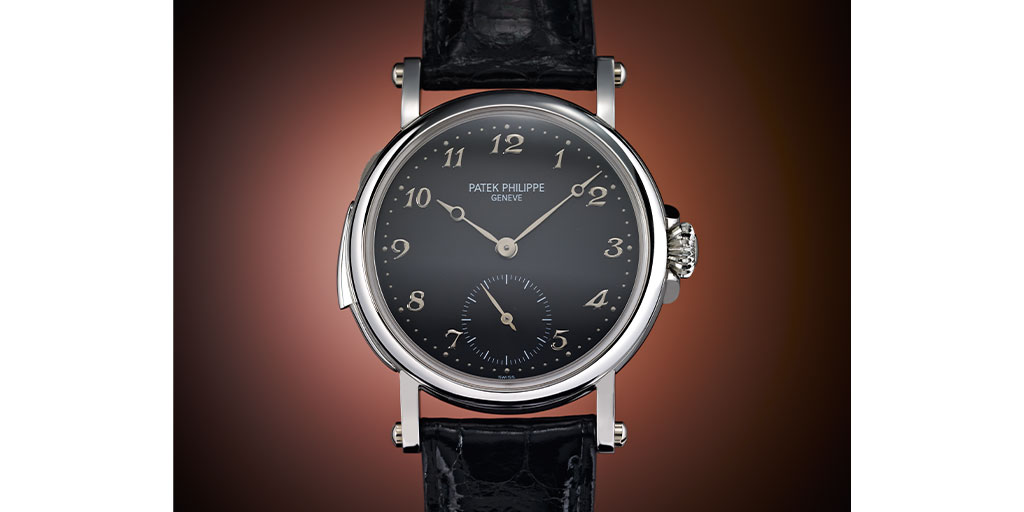
As with the 150th anniversary, a special, limited edition minute repeater was produced, the ref. 5029. The company again looked to the past for the design of the case, and the ref. 5029 was housed in a classic Officer’s-style from 1915, when Patek Philippe first produced a minute repeating wristwatch. Even the buckles and case lugs were designed to reflect the original Officer’s-style with screw pins securing the case and buckle to the strap. The 35 mm case was created by the world renowned Jean-Pierre Hagmann (JPH), a talented and respected individual known for his work on some of the most prestigious Patek minute repeater cases such as references 3974 and 3979.
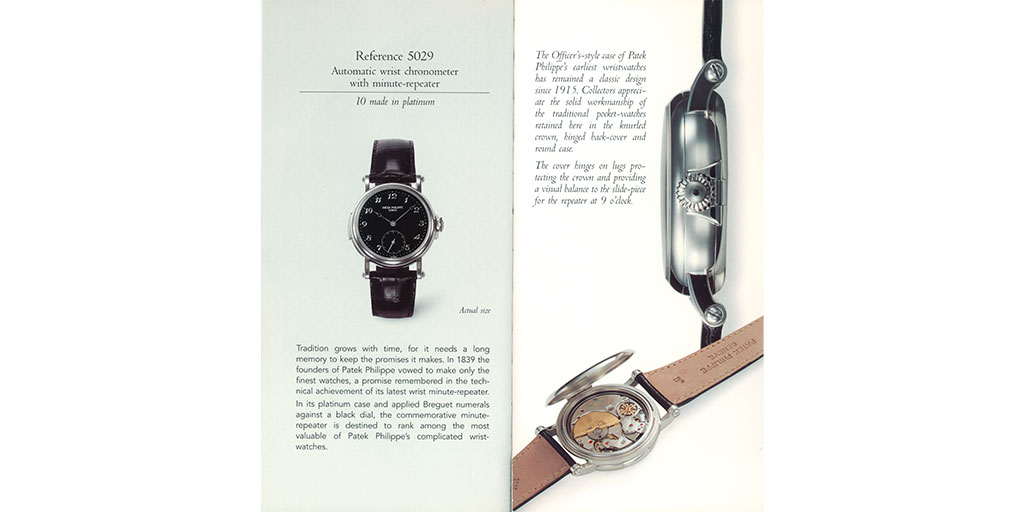
The hinged back cover, also reminiscent of early pocket watches, revealed the magnificent, ultra-thin, self-winding minute repeater caliber R 27 PS movement which incorporates an off-set winding rotor that permits space for the two minute repeating gongs. The caliber was introduced in 1989 when Philippe Stern decided to produce a minute repeater movement completely in house rather than work on an ebauche from makers such as Victorin Piguet. For the production of this movement, Patek commissioned advanced metallurgical research to develop an acoustic steel that chimes in the confines of a wristwatch. As a result, nothing affects the clear, sharp chime of the repeaters, not even the spinning speed-regulator that governs the strike of the twin hammers in burnished steel. The sound of a Patek Philippe minute repeater is in a league of its own and each timepiece does not leave the workshops until either Philippe or Thierry Stern have personally listened to the chime and assured its quality. (For more information, please see our Minute Repeaters In-Depth post).
The ref. 5029 was only made in the following limited numbers: 10 in platinum with applied white gold Breguet numerals and hands against a black dial; 10 in 18K rose gold with a silvered dial and rose Breguet numerals and hands; and 10 in 18K yellow gold with gold applied Breguet numerals and hands on a champagne-colored dial. These pieces were sold through the Patek Philippe boutique in Geneva for around 276,000 CHF. So far, around seven yellow gold, six rose gold and six platinum watches have appeared on the market. Occasionally, pieces reach the auction market, most recently in 2019 a ref. 5029R sold for 312,000 USD at Sotheby’s. A platinum piece sold at Christie’s for 4,820,000 HKD (approx. 620,000 USD) in 2010. As with all Patek Philippe minute repeaters, the ref. 5029 is a sought after model for collectors.
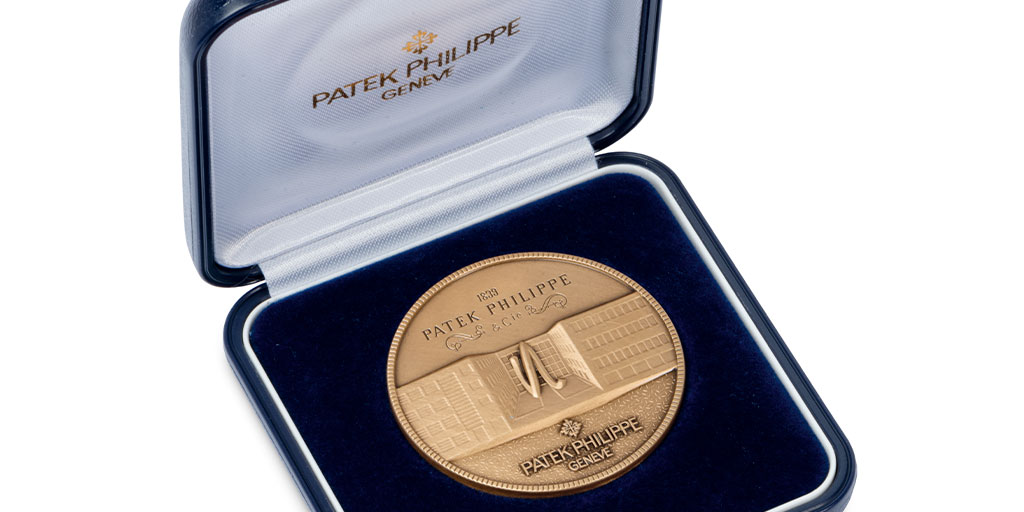
Each commemorative watch was delivered with a silver medal specially minted to celebrate the inauguration (above).
Since the completion of the new workshops at Plan-les-Ouates, two new buildings have been erected. Philippe Stern’s plan that the original workshop building would accommodate the growth of his firm for twenty-five years, lasted a total of five. The second building, a case and bracelet manufacture located nearby in Perly was opened in 2003. Last year, under the planning of both Philippe and his son Thierry Stern, the inauguration of an enormous third new building located on what had been the staff carpark at Plan-les-Ouates took place. Before building began, an excavation equivalent to the same area as 90 Olympic swimming pools had to be removed, and formwork built that would cover 15 football fields. A finished total of approximately 1,438,600 square feet is arranged over ten floors which includes a training floor, four production floors, four basement floors (two for equipment and two for parking) and a top-floor restaurant with views to envy. As with the original Plan-les-Ouates building, the workshops are light-filled and expansive. In 2020, to commemorate the latest building inauguration ref. 6007A was released in a limited edition of 1,000 pieces. The 40 mm Calatrava is fitted with a self-winding caliber 324 SC with a sapphire crystal case back. The distinctive gray-blue dial is decorated with a chemin de fer hour circle and applied Arabic numerals. As with the watches commemorating the 1997 inauguration, the ref. 6007A case back has a special inscription. The question is, when will Thierry Stern invite his son to study the plans for the next building and what will the inscription be for the inauguration limited edition watches?
Our next In-Depth will look at the commemorative timepieces to celebrate the new millennium.

